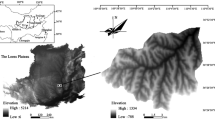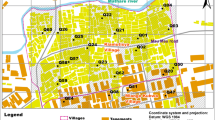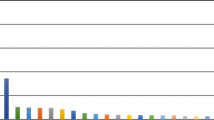Abstract
Social interaction has become one of the key factors affecting the spatial reconstruction of rural settlements (SRRS). However, most studies ignored the multi-scale impact of social networks on the identification of restructuring types of rural settlements. This paper, taking Ezhou City of Hubei Province, China as the case study area, developed a potential inter-settlement network through considering settlements as nodes, and inter-settlement interactions induced by the spatial disparity of public facilities as edges, divided towns in Ezhou City into three zones based on community structure at the town level, and then identified four types of rural settlements in light of the characteristics of cluster patterns and centrality at the patch level. The results show that the inter-settlement network in Ezhou City presents apparent disparities in terms of community structure, cluster patterns and centrality. In community analysis, high inter-community and intra-community interactions are concentrated in well-developed areas in the north and east, while weak interactions between communities occur in the southern areas dominated by traditional agricultural production. Accordingly, three zones are divided such as the urban-leading zone, urban-rural integration zone and rural-leading zone. For the network centrality and cluster patterns, high-level rural settlements are mainly distributed in the urban-leading zone, followed by the urban-rural integration zone and the rural-leading zone. Moreover, the lump cluster pattern is observed in each zone, but the chain pattern and dispersed pattern largely occur in the rural-leading zone. At same time, four types of rural settlements are identified, namely urbanized settlements, central settlements, grassroots settlements and relocated settlements. The corresponding plans are discussed in different zones regarding urbanization, integration and characteristics to provide meaningful insights for policymakers to guide SRRS. This study would contribute to our understanding of the impact of social network involved in daily life on rural settlement reconstruction, and expect to provide theoretical and methodological support for rural sustainable development in practice.
Similar content being viewed by others
References
Cao W W, Feng X N, Zhang H, 2019. The structural and spatial properties of the high-speed railway network in China: a complex network perspective. Journal of Rail Transport Planning&Management, 9: 46–56. doi: https://doi.org/10.1016/j.jrtpm.2018.10.001
Chen R S, Ye C, Cai Y L et al., 2014. The impact of rural out-migration on land use transition in China: past, present and trend. Land Use Policy, 40: 101–110. doi: https://doi.org/10.1016/j.landusepol.2013.10.003
Cui J X, Luo J, Kong X S et al., 2019. Characterising the hierarchical structure of urban-rural system at county level using a method based on interconnection analysis. Journal of RuralStudies., doi: https://doi.org/10.1016/j.jrurstud.2019.10.013
Erath A, Löchl M, Axhausen K W, 2009. Graph-theoretical analysis of the swiss road and railway networks over time. Networks and Spatial Economics, 9(3): 379–100. doi: https://doi.org/10.1007/s11067-008-9074-7
Ezhou City Bureau of Statistics, Hubei Province, 2015–2020. Statistical yearbook of Ezhou 2020. Beijing: China Statitics Press. (in Chinese)
Faust K, Entwisle B, Rindfuss R R et al., 2000. Spatial arrangement of social and economic networks among villages in Nang Rong District, Thailand. Social Networks, 21(4): 311–337. doi: https://doi.org/10.1016/S0378-8733(99)00014-3
Fei X T, Hamilton G G, Wang Z, 1992. From the Soil: the Foundations of Chinese Society. Berkeley: University of California Press, 37–44.
Gieling J, Haartsen T, Vermeij L, 2019. Village facilities and social place attachment in the rural netherlands. Rural Sociology, 84(1): 66–92. doi: https://doi.org/10.1111/ruso.12213
Hang X, Payne D, 2017. Characteristics of Chinese rural networks: evidence from villages in central China. Chinese Journal of Sociology, 3(1): 74–97. doi: https://doi.org/10.1177/2057150x16678593
He J H, Li C, Yu Y et al., 2017. Measuring urban spatial interaction in Wuhan Urban Agglomeration, Central China: a spatially explicit approach. Sustainable Cities and Society, 32: 569–583. doi: https://doi.org/10.1016/j.scs.2017.04.014
He Q S, Tan S K, Yin C H et al., 2019. Collaborative optimization of rural residential land consolidation and urban construction land expansion: a case study of Huangpi in Wuhan, China. Computers, Environment and Urban Systems, 74: 218–228. doi: https://doi.org/10.1016/j.compenvurbsys.2018.11.005
Hosseini S B, Faizi M, Norouzian-Maleki S et al., 2015. Impact evaluation of rural development plans for renovating and retrofitting of rural settlements. Environmental Earth Sciences, 73(7): 3033–3042. doi: https://doi.org/10.1007/s12665-011-1403-3
Hou H P, Liu Y L, Liu Y F et al., 2015. Using inter-town network analysis in city system planning: a case study of Hubei Province in China. Habitat International, 49: 454–465. doi: https://doi.org/10.1016/j.habitatint.2015.06.016
Hu Q Y, Wang C, 2020. Quality evaluation and division of regional types of rural human settlements in China. Habitat International, 105: 102278. doi: https://doi.org/10.1016/j.habitatint.2020.102278
Huff D L, 1963. A probabilistic analysis of shopping center trade areas. Land Economics, 39(1): 81–90. doi: https://doi.org/10.2307/3144521
Isaac M E, Matous P, 2017. Social network ties predict land use diversity and land use change: a case study in Ghana. Regional Environmental Change, 17(6): 1823–1833. doi: https://doi.org/10.1007/s10113-017-1151-3
Kong X S, Liu D F, Tian Y S et al., 2021. Multi-objective spatial reconstruction of rural settlements considering intervillage social connections. Journal of Rural Studies, 84: 254–264. doi: https://doi.org/10.1016/j.jrurstud.2019.02.028
Li Y H, Li Y R, Westlund H et al., 2015. Urban-rural transformation in relation to cultivated land conversion in China: implications for optimizing land use and balanced regional development. Land Use Policy, 47: 218–224. doi: https://doi.org/10.1016/j.land-usepol.2015.04.011
Li Y R, Liu Y S, Long H L et al., 2014. Community-based rural residential land consolidation and allocation can help to revitalize hollowed villages in traditional agricultural areas of China: evidence from Dancheng County, Henan Province. Land Use Policy, 39: 188–198. doi: https://doi.org/10.1016/j.landusepol.2014.02.016
Li Y R, Qiao L Y, Wang Q Y et al., 2020. Towards the evaluation of rural livability in China: theoretical framework and empirical case study. Habitat International, 105: 102241. doi: https://doi.org/10.1016/j.habitatint.2020.102241
Liu D F, Kong X S, Zhou B Y et al., 2019. Spatial optimization of rural settlement relocation by incorporating inter-village social connections under future policy scenarios. Transactions in GIS, 23(4): 688–704. doi: https://doi.org/10.1111/tgis.12528
Liu W P, Yang C X, Liu Y et al., 2018. Impacts of concentrated rural resettlement policy on rural restructuring in upland areas: a case study of Qiantang Town in Chongqing, China. Land Use Policy, 77: 732–744. doi: https://doi.org/10.1016/j.landusepol.2018.06.011
Liu Yansui, Yang Ren, Li Yuheng, 2013. Potential of land consolidation of hollowed villages under different urbanization scenarios in China. Journal of Geographical Sciences, 23(3): 503–512. doi: https://doi.org/10.1007/s11442-013-1024-8
Long H L, Liu Y S, Li X B et al., 2010. Building new countryside in China: a geographical perspective. Land Use Policy, 27(2): 457–470. doi: https://doi.org/10.1016/j.landusepol.2009.06.006
Long H L, Li Y R, Liu Y S et al., 2012. Accelerated restructuring in rural China fueled by ‘increasing vs. decreasing balance’ land-use policy for dealing with hollowed villages. Land Use Policy, 29(1): 11–22. doi: https://doi.org/10.1016/j.landusepol.2011.04.003
Long Hualou, 2014. Land consolidation: an indispensable way of spatial restructuring in rural China. Journal of GeographicalSciences, 24(2): 211–225. doi: https://doi.org/10.1007/s11442-014-1083-5
Long H L, Tu S S, Ge D Z et al., 2016. The allocation and management of critical resources in rural China under restructuring: problems and prospects. Journal of Rural Studies, 47: 392–412. doi: https://doi.org/10.1016/j.jrurstud.2016.03.011
Lu M Q, Wei L Y, Ge D Z et al., 2020. Spatial optimization of rural settlements based on the perspective of appropriateness-domination: a case of Xinyi City. Habitat International, 98: 102148. doi: https://doi.org/10.1016/j.habitatint.2020.102148
Ma W Q, Jiang G H, Zhang R J et al., 2018. Achieving rural spatial restructuring in China: a suitable framework to understand how structural transitions in rural residential land differ across peri-urban interface?. Land Use Policy, 75: 583–593. doi: https://doi.org/10.1016/j.landusepol.2018.04.024
Estch A, Marconcini M, Marmanis D et al., 2014. Dimensioning urbanization-An advanced procedure for characterizing human settlement properties and patterns using spatial network analysis. Applied geography, 55: 212–228. doi: https://doi.org/10.1016/j.apgeog.2014.09.009
Milbourne P, Kitchen L, 2014. Rural mobilities: connecting movement and fixity in rural places. Journal of Rural Studies, 34: 326–336. doi: https://doi.org/10.1016/j.jrurstud.2014.01.004
National Bureau of Statistics of China, 2020. China Statistical Yearbook 2020. Beijing: China Statistics Press. (in Chinese)
Newman M E J, Girvan M, 2004. Finding and evaluating community structure in networks. Physical ReviewE, 69(2): 026113. doi: https://doi.org/10.1103/PHYSREVE.69.026113
Opsahl T, Agneessens F, Skvoretz J, 2010. Node centrality in weighted networks: generalizing degree and shortest paths. Social Networks, 32(3): 245–251. doi: https://doi.org/10.1016/j.socnet.2010.03.006
Porta J, Parapar J, Doallo R et al., 2013. A population-based iterated greedy algorithm for the delimitation and zoning of rural settlements. Computers, Environment and Urban Systems, 39: 12–26. doi: https://doi.org/10.1016/j.compenvurbsys.2013.01.006
Rao J, 2020. Comprehensive land consolidation as a development policy for rural vitalisation: Rural In Situ Urbanisation through semi socio-economic restructuring in Huai Town. Journal of Rural Studies. doi: https://doi.org/10.1016/j.jrurstud.2020.09.009
Su Rui, Wang Cheng, 2018. Rural settlement spatial layout optimization using network center radiation guidance for Yanba Village in Chongqing. Resources Science, 40(5): 958–966. (in Chinese)
Tacoli C, 1998. Rural-urban interactions: a guide to the literature. Environment and Urbanization, 10(1): 147–166. doi: https://doi.org/10.1177/095624789801000105
Tian Y S, Kong X S, Liu Y L et al., 2016. Restructuring rural settlements based on an analysis of inter-village social connections: a case in Hubei Province, Central China. Habitat International, 57: 121–131. doi: https://doi.org/10.1016/j.habitatint.2016.07.007
Tian Y S, Kong X S, Liu Y L, 2018. Combining weighted daily life circles and land suitability for rural settlement reconstruction. Habitat International, 76: 1–9. doi: https://doi.org/10.1016/j.habitatint.2018.05.005
Wang Feng, Liu Yanfang, Kong Xuesong, 2016. Analysis of spatial interaction in rural society based on theory of social network: a case of Liji Town in Wuhan City. Economic Geography, 36(4): 141–148, 202. (in Chinese)
Wang Y, Jin C, Lu M Q et al., 2017. Assessing the suitability of regional human settlements environment from a different preferences perspective: a case study of Zhejiang Province, China. Habitat International, 70: 1–12. doi: https://doi.org/10.1016/j.habitatint.2017.09.010
Wong J C, Ding W Z, Wang D M et al., 2016. Sustaining social networks in community design: a case study of Yangze village, China. Annals of GIS, 22(4): 287–300. doi: https://doi.org/10.1080/19475683.2016.1230890
Xia H, Li C Z, Zhou D et al., 2020. Peasant households’ land use decision-making analysis using social network analysis: a case of Tantou Village, China. Journal of Rural Studies, 80: 452–468. doi: https://doi.org/10.1016/j.jrurstud.2020.10.023
Zhang W L, Chong Z H, Li X J et al., 2020. Spatial patterns and determinant factors of population flow networks in China: analysis on Tencent Location Big Data. Cities, 99: 102640. doi: https://doi.org/10.1016/j.cities.2020.102640
Zhao X, Sun H B, Chen B et al., 2019. China’s rural human settlements: qualitative evaluation, quantitative analysis and policy implications. Ecological Indicators, 105: 398–405. doi: https://doi.org/10.1016/j.ecolind.2018.01.006
Author information
Authors and Affiliations
Corresponding author
Additional information
Foundation item
Under the auspices of the National Natural Science Foundation of China (No. 41871301)
Rights and permissions
About this article
Cite this article
Yue, Q., He, J. & Liu, D. Identifying Restructuring Types of Rural Settlement Using Social Network Analysis: A Case Study of Ezhou City in Hubei Province of China. Chin. Geogr. Sci. 31, 1011–1028 (2021). https://doi.org/10.1007/s11769-021-1236-2
Received:
Accepted:
Published:
Issue Date:
DOI: https://doi.org/10.1007/s11769-021-1236-2




